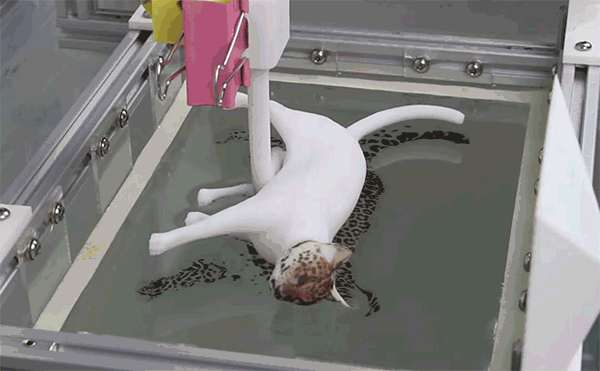Since the 80’s hydrographic printing has been used as a relatively simple way to transfer images onto 3D objects. While perfect for applying a repeated pattern onto an item, hydrographic printing often lacks the precision needed for more detailed, specific texture mapping. Researchers from Zheijiang University, however, have presented a new method at SIGGRAPH 2015 that demonstrate a very precise hydrographic printing technique that might make it possible to create full-color 3D prints.
Hydrographic printing involves dipping a colored or patterned PVA film in water, treating it with an activator chemical, and dipping a three-dimensional object into the water, allowing the film to wrap around it and stick to it. Recognizing the limitations of the process, the Zheijian team developed what they call “computational hydrographic printing.” To make the mapping more precise, the researchers began by building a tightly-controlled rig, so that a 3D printed object could be dipped with fine accuracy. Then, they created software to simulate the stretching of the film as the object was immersed in their custom tank, allowing them to predict how the image would match the 3D object. Needless to say, it’s nuts.
In addition to using custom 3D printed items, the team also used existing goods. By 3D scanning a purchased ceramic mug, they were able to accurately map the object before immersing it in its film. They also created a “multi-immersion” system to dip the objects into the tank a few times and apply subsequent layers. In the animated leopard .gif above, this process was used to apply the texture to each side of the print.
The researchers admit that the method is far from perfect. For instance, in the case of highly complex models, with obstructed regions, the film might not work itself into the object’s nooks and crannies. The colors, too, might not be perfect, with colors fading as the film is stretched. Nevertheless, it’s an exciting idea with potential that I can’t even wrap might head around. The mind begins to whirl with thoughts of printing video game characters and applying the same digital texture maps to their physical forms. Does that make sense?
For those of you playing at home, you can follow along with their research here (.pdf). If you’re looking for a less intense hydrographics process and just want to apply patterns to your prints, last year, le FabShop wrote up a great Instructable on relatively simple DIY hydrographics printing here.





